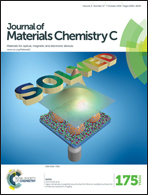Vapor-enhanced covalently bound ultra-thin films on oxidized surfaces for enhanced resolution imaging†
Abstract
Vapor-phase covalently bound siloxane thin films of various functionalities on a variety of surfaces, including glass, aluminum, and polyester, were demonstrated in a one-step process. Siloxane films a few nanometers thick were deposited on surfaces from the vapor phase using different inert polydimethylsiloxanes (PDMSs) without the use of solvent, initiator, or a crosslinking agent. Functional PDMSs fluoro-polysiloxane (F-PDMS) and amino-polysiloxane (A-PDMS) were also coated on glass substrates, providing functional surfaces for patterned array of microlenses (MLs) for near-field imaging applications. We call our siloxane film deposition method SOLVED which refers to Siloxane-bound Layers through Vapor-Enhanced Deposition. Our ellipsometry data on the PDMS SOLVED surfaces indicated the film thickness was 6.5 ± 0.3 nm. The siloxane–surface binding was a thermally activated reaction with an apparent activation energy of ∼11 kcal mol−1. Our optical spectroscopic X-ray photoelectron spectroscopy (XPS), Fourier-transform infrared spectroscopy (FTIR) and mass-spectrometry analysis data provided strong evidence that the SOLVED films retained the chemical nature of the polymers used for the coatings. The redox diffusion coefficients of Fe(CN)64−/3− species on SOLVED films using cyclic voltammetry (CV) studies were comparable with that of highly packed C18-silane self-assembled monolayers (SAMs) on ITO surfaces – implying high quality pinhole-defect-free SOLVED coatings on the surfaces. Further, both the CV and water contact angle (CA) measurements indicated that the photostability of SOLVED and octadecyltrimethoxysilane (OTMS) SAM films on the ITO substrates was comparable. Unlike bulk PDMS, our ultra-thin SOLVED films did not exhibit any significant changes in the water CA over two weeks. A reproducible and stable hydrophobicity with tunable water CAs between 30° and 97° was obtained through plasma treatment. By selectively removing the SOLVED films thru oxygen plasma treatment, we demonstrated the fabrication of self-assembled aqueous ZnCl2 ML array. Near-field imaging using MLs yielded much higher spatial resolution than can be obtained using diffraction-limited wide-field imaging.


 Please wait while we load your content...
Please wait while we load your content...